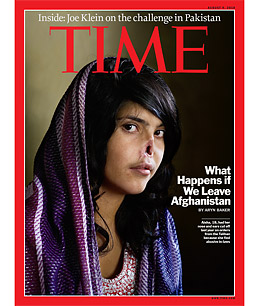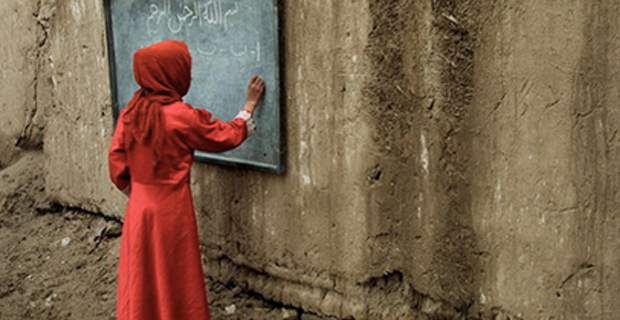by Najam Haider
This article is part of an ongoing series that will examine what Shari’ah is, how the media often get it wrong, and how it’s being used to create fear of Islam and Muslims and to justify continued military defense of “American values.”
The recent Time magazine cover featuring the disfigured face of a woman identified only as Aisha and accompanied by the caption “What happens if we leave Afghanistan?” has raised a maelstrom of controversy in the blogosphere. A number of voices have criticized the article for its presentation of a false dichotomy (either we stay and women are relatively safe or we leave and they will all be horribly oppressed) while others have criticized the politicized use of the image itself. In reality, this type of argument is part and parcel of a broader discourse on women’s rights in Afghanistan (and the entire Muslim world).
Last spring, the Afghani parliament raised a similar international uproar with its passage of a personal status law governing the Shi‘i minority that contained provisions that appeared to legalize marital rape and severely restricted a married woman’s ability to leave her home. Human rights organizations and concerned political groups in Kabul organized protests against the law and accused Hamid Karzai,the president of Afghanistan, of backing it in exchange for support in the August 2009 elections. The press forwarded both instances as examples of the Taliban’s effort to enforce Shari‘a, a term vaguely but routinely translated as “Islamic law” with broad connotations of immutability and universality. The problem with such a discourse lies in its fundamental misreading of the Shari‘a which – in turn – distorts economics and social issues by framing them exclusively in terms of religion.
The mainstream press often translates Shari‘a as Islamic law and describes it as a comprehensive and all-inclusive set of rules either articulated in the Qur’an or modeled by Muhammad in the 7th century. The rules are depicted as draconian, reactionary, and deaf to appeals of gender inequity. The Shari’a is also invoked by political Islamist groups in the Middle East and North Africa to justify their ideological agendas. Both the press and these Islamist groups, however, fundamentally misread and distort the term which has a technical meaning tied to law.
According to Muslim scholars (across the centuries), Shari‘a is the human attempt to understand God’s will in a given place and at a given time. This is done by systematically examining evidence in a manner that balances the requirements of religious texts (primarily the Qur’an) against the needs of society (context). It is this methodology or approach, defined as fiqh (or jurisprudence) which gives a legal system its Islamic character. The rules that emerge from this process are collectively referred to as the Shari‘a.
In this enterprise, limits of interpretation are provided by a small number of rules explicitly mentioned in the Qur’an. While these laws are theoretically immutable, they are nonetheless open to contextualization and have (on many occasions) been restricted in their application by Muslim jurists. In other words, as society changes, so does the Shari‘a which embodies the broader Muslim community’s attempt to provide a legal code resonant with its unique circumstances. In fact, if the Shari‘a is to maintain its influence, it *must* change. Otherwise it risks marginalizing itself from the practical needs of society and thereby relegating itself to irrelevance.
An example of this dynamic can be found by comparing the Shari‘a in 16th century Egypt to that of southern Spain. Muslim scholars in each region were forced to deal with very different political and social contexts. Egypt was ruled by a stable Muslim government with little threat of foreign invasion. Consequently, Egyptian jurists held that hiding one’s Islamic faith was unacceptable and deemed it illegal to live in a nation ruled by a non-Muslim dynasty. Southern Spain, on the other hand, had been reconquered by Spanish Catholics in 1492 and the Inquisition had forced the large Muslim population underground.
In this situation, an entire corpus of law was developed to allow for the continuation of religious life in a state of secrecy. Both legal codes — in Egypt and Spain — were considered valid manifestations of the Shari‘a with contradictions ascribed to radically different contexts. The element that bound both of these Shari‘as together was their common legal methodology. The fact that the same approach yielded contradictory results did not raise eyebrows as it was understood that the circumstances of each community were fundamentally different.
Shari‘a is a product of an approach to evidence as opposed to an immutable set of laws. Possessing a significant degree of flexibility, it evolves to fit the changing needs and expectations of a given society. This fact is particularly important when considering the most controversial element of the Afghan personal status law, namely the marriage contract clause which (a) rejects the possibility of marital rape and (b) restricts a wife’s freedom of movement. While these provisions were almost universally articulated by Muslim jurists throughout the centuries, they are not mentioned in the text of the Qur’an and are therefore open to a degree of reinterpretation.
In fact, the marriage regulations in question were formulated by a group of scholars born and raised in male-dominated societies and reflect a general understanding of marriage prevalent in most traditional societies. Changes in these expectations only emerged in Europe and the United States over the last half century commensurate with huge strides in female education. Afghanistan has seen few such changes and traditional notions of tribe and assumptions regarding gender remain ingrained in most parts of the country outside of Kabul.
The personal status law in Afghanistan embodies a traditional understanding of marriage as opposed to a core Islamic religious value. This law appears draconian and oppressive to modern sensibilities but – and this is the central problem – in the countryside it embodies the general expectations of marriage. While repealing the problematic clauses is useful to the extent that it denies official sanction to the disempowerment of women, it does not address the underlying social dynamic. The belief that a woman must be sexually available to her husband and cannot leave the home without permission will persist as the informal law of the land in most of Afghanistan outside the few cosmopolitan urban centers.
Substantive change requires significant investment in the education of women which – in turn – will facilitate a change in perceptions of both marriage and the right to a basic freedom of movement. The pressure of social change has historically pushed Muslim scholars to re-engage the source texts through the rules of jurisprudence to accommodate a new historical situation. Examples of this process abound in countries like Egypt and Iran where the rise in the education levels of women have precipitated significant reforms in family law provisions of the Shari‘a.
To criticize the attack on Aisha or the Afghan personal status law as the culmination of some immutable and rigid Shari‘a misreads both the situation on the ground in Afghanistan and the nature of Islamic law. This perspective takes issues tied to social and economic development (mainly education) and portrays them as unchanging and essential religious values. In doing so, it overlooks the fact that the Shari‘a is both mutable and adaptable in light of changes in society at large.
The best avenue to facilitate the introduction of more progressive interpretations of personal law and to protect women from horrible violence (as in the case of Aisha) is through a heavy investment in the education of women and broader economic development. As societal attitudes towards gender evolve and change, the Shari‘a will also adapt in a process that has played out countless times in the Muslim world over the last millennium. By framing gender issues in Afghanistan in religious terms (as opposed to highlighting their connection to a particular social and economic context), we mistake a side effect for a central cause.
Najam Haider is an Assistant Professor in the Department of Religion at Barnard College. His current research focuses on the identity politics of religious minorities in the early Muslim world. He has previously taught at New York University, Georgetown University, and Franklin and Marshall College.


